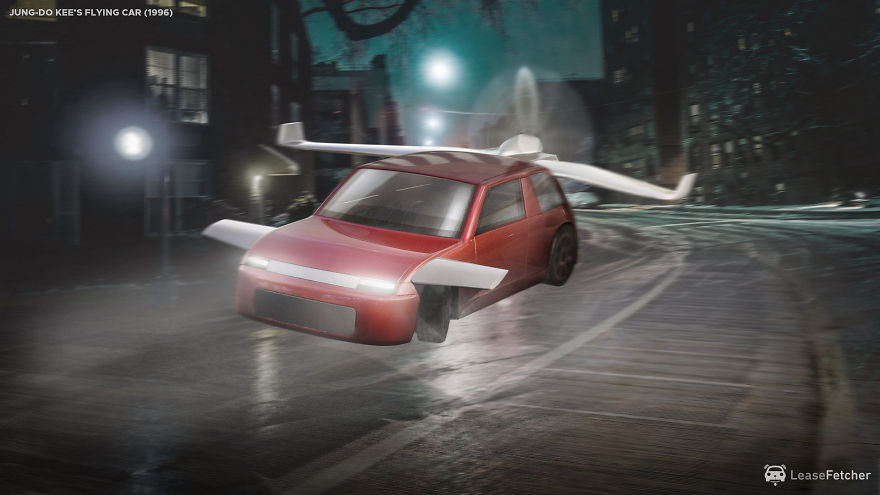When we imagine a bright future and the evolution of technology, the first thing that pops into our minds is always a flying car. The idea of crossing skies in an air vehicle has fascinated humankind: from drivers to engineering enthusiasts to sci-fi creators since the beginning of the automobile era.
Vehicle leasing comparison start-up, LeaseFetcher, collaborated with 3D artists at NeoMam Studios to bring to life eight of the most mind-blowing real flying car concepts that almost made it in a series of digital renders. These prototypes dating from 1912 and created by a few of the most ambitious and creative car designers and inventors reached the patent stage, yet never hit the cloud roads.
There are many speculations and predictions as for when the first “autoplane” will appear, but until someone finally adds an “up” gear to modern vehicles, check out how these surreal car models would look if the future was now.
More info: leasefetcher.co.uk
Henry J Snook’s flying car (1912)
King of the skies and scourge of the birds, Snook’s airborne Winnebago looks like a real menace – just look at that pair of giant revolving corkscrew propellers. The rotor rods spin right through the chassis of the cylindrical, bus-length chassis, so perhaps they could be painted nicely to resemble a barber’s pole.
Little is known about Henry Snook, but among his other inventions, he created a fire rescue truck and a contraption to harness the power of ocean waves (again using his beloved corkscrew rotor). His flying vehicle may be more Rube Goldberg than Elon Musk, but Snook seems to have never lost the childhood passion for inventing cool stuff that spins and flies and is preferably painted a fetching shade of racing green.
Patent No: US1069906A
Bruce L Beals Jr’s flying car (1939)
Bruce Beal’s bubble-shaped flying automobile appears to have been drawn with Little Miss Scatterbrain in mind. But its shape and weight were in fact designed to operate as the fuselage and motor housing for the vehicle when it takes flight.
The steering wheel mechanism is combined with a shock absorber so as to allow a damage-free landing. And in case you’re a little more “Fools and Horses” than “Mr. Men,” Beal stresses his pre-war flying car could work as a four-wheel or three-wheel model.
Patent No: US2241577A
Einarsson Einar’s flying car (1959)
Like any good sci-fi flying car, Einar’s design transforms itself from air- to road-vehicle by means of seamless flaps and hidden compartments for the propellers. The wings can pivot when mounted, and the rotors can be switched between pull and push mode depending on conditions.
Unfortunately, the patent lacks details on the safety features that, frankly, you would want to know about before getting on board this thing. Einar’s sleek airborne sedan may have a Jetsons feel about it, but its lack of legroom suggests drivers might prefer to put their feet on the ground and attempt a running start more reminiscent of the Flintstones.
Patent No: US3090581A
Jung-Do Kee’s flying car (1996)
Korean designer Jung-Do Kee decided to solve the problem of poorly-balanced, nose-diving air-cars. His solution? Putting the rear-propulsion propeller at the back and rather fetching horizontal stabilizer plates in front of the main wing. The steering wheel and accelerator pedal are linked to a lifting hoist to add a little more pluck to the front-end as needed.
Now, nobody is suggesting that Jung-do has basically plonked wings and a propeller randomly onto a Renault 5, but… well, okay, that’s exactly what our researcher suggested. Still, it’s a nice little runaround-and-up-and-down.
Patent No: KR100222085B1
Bradford Sorensen’s flying car (2001)
Sorensen’s tear-shaped “Roadable aircraft boat that flies in a wind of its own making” is a smooth proposition. Counter-rotating blades draw air into wing-shaped “sucked flaps,” and the difference in pressure above and below these airfoils lifts the beast into the sky. The wings fit neatly into the roof of the roadable aircraft, so there’s no need for ‘Transformers’-style extension and retraction.
Not much is known about Sorensen, but among other inventions, he has also offered a “cylindrical spiral roll of flexible durable material” that takes the pain out of giving birth. Meanwhile, his car patent is relatively recent and at least looks viable, so he is probably keeping a watchful eye on the big-money developments of today’s would-be flying car manufacturers.
Patent No: US20020139894A1
Chéng Jì’s flying car (2001)
Now, this “water-flapping flying car” is really something new. Biomimicry (tech inspired by nature) is the word. It looks like something Jeff Goldblum might have chosen to drive as ‘The Fly,’ although the patent claims it to be bird or bat-inspired.
The water-flapping flying car can “sneak into the water like a seabird, use the wings as propellers and control the snorkeling,” and the wings “can be folded like a bird” so that it fits on your driveway. However, it can also fly backward and perform various other manoeuvres that even our feathered friends can’t do. Bonus points: this vehicle is ready for driverless flight software to be uploaded.
Patent No: CN1377790A
Larry D Long’s flying car (2003)
Mr. Long co-authored his 2003 patent application with Terry L. Sturgeon in the noble cause of curing terrestrial traffic congestion.
The vehicle borrows its shape and its interface from the conventional motor car, with an extra steering-wheel-within-a-steering-wheel to coordinate control of the front and rear rotors. Sleek design and multiple horizontal and vertical propellers give Larry and Terry’s flying car the look of a Star Trek shuttlecraft or fancy telephone handset.
Patent No: US6745977B1
Akash Girendra Barot’s flying car (2016)
Barot’s drone-like vehicle features four vertical lift rotors, spreading the weight of the car evenly to ensure a balanced flight. The quadcopter boasts the ability to rise directly upwards during take-off, a feature that will be appreciated by drivers fed up of getting boxed-in by inconsiderate parkers.
Once more, the Jetsons influence is on display – this time in the vehicle’s suitability to everyday family use (from home to work or to the supermarket). Fittingly, we’ve coated this ‘Corolla-in-the-sky’ in a 1970s-kitchen shade of pea green.
Patent No: US20180065435A1
6Kviews
Share on FacebookWhy not just get a helicopter? It is a proven technology and would have better functionality than any flying car that has been designed.
Why not just get a helicopter? It is a proven technology and would have better functionality than any flying car that has been designed.

 Dark Mode
Dark Mode 

 No fees, cancel anytime
No fees, cancel anytime 






















































46
10